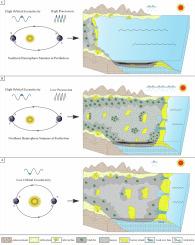Impact of astronomical forcing on sea-level changes and peat-swamp development in the Late Paleozoic of North China
IF 2.7
2区 地球科学
Q2 GEOGRAPHY, PHYSICAL
Palaeogeography, Palaeoclimatology, Palaeoecology
Pub Date : 2025-08-28
DOI:10.1016/j.palaeo.2025.113232
引用次数: 0
Abstract
The Late Paleozoic Ice Age represents a critical phase of coal accumulation in the North China Basin. Coal was primarily deposited in marine-terrestrial transitional environments, where coal seams display distinct cyclicity closely associated with cyclic marine transgressions. Astronomical cycles are believed to play a crucial role in the evolution of climate and environmental changes during the Late Paleozoic Ice Age. To explore the impact of astronomical cycles on sea-level changes and peat swamp development, and to clarify the relationship between astronomically forced transgressions and the termination of peat swamp development, a time-series and cyclostratigraphic analysis were conducted on the Taiyuan Formation gamma ray (GR) data from well H-2 in Juye, Shandong. A floating astronomical time scale of ∼4.55 Myr for the Taiyuan Formation is constructed by astronomical tuning of GR data to the robust ∼405 kyr eccentricity cycle. Sea-level changes of the Taiyuan Formations are recovered based on the sedimentary noise model. Cyclostratigraphic analysis indicates that the high-frequency, cyclic deposition of limestone transgressive layers and coal seams was impacted by astronomical forcing. During periods of high orbital eccentricity with low precession, the Northern Hemisphere summer solstice at perihelion, resulting in warm and humid climatic conditions, enhanced precipitation, and promoting vegetation growth and peat swamp development. In contrast, high precession aligned the Southern Hemisphere summer solstice with perihelion, creating a warm summer orbit that maximized insolation and temperatures, thereby accelerating the deglaciation and collapse of Gondwana and triggering sea-level rise. Following the accumulation of glacial melt from multiple high-precession phases, rising sea-levels eventually surpassed the strait heights, leading to seawater intrusion, which submerged the peat swamps and terminated their development. The peat was preserved and subsequently formed coal seams. An ideal model was established to illustrate how astronomical forcing influences sea-level changes and the development and termination of peat swamps.

天文强迫对华北晚古生代海平面变化和泥炭沼泽发育的影响
晚古生代冰期是华北盆地成煤的关键时期。煤主要沉积于海陆过渡环境,煤层具有明显的旋回性,与旋回海侵密切相关。天文周期被认为在晚古生代冰期气候和环境变化的演变中起着至关重要的作用。为探讨天文旋回对海平面变化和泥炭沼泽发育的影响,明确天文强迫海侵与泥炭沼泽发育终止的关系,对山东巨野H-2井太原组伽玛射线(GR)资料进行了时间序列和旋回地层分析。通过天文调整GR数据到稳健的~ 405 kyr偏心周期,构建了太原组的浮动天文时间尺度为~ 4.55 Myr。基于沉积噪声模型恢复了太原组的海平面变化。旋回地层分析表明,灰岩海侵层和煤层的高频旋回沉积受到天文强迫的影响。在轨道高偏心率和低岁差时期,北半球夏至处于近日点,导致气候条件温暖湿润,降水增加,促进植被生长和泥炭沼泽发育。相反,高岁差使南半球夏至与近日点对齐,形成了一个温暖的夏季轨道,最大限度地增加了日照和温度,从而加速了冈瓦纳的冰川消融和崩塌,并引发了海平面上升。随着多个高进动期冰川融水的积累,海平面上升最终超过了海峡高度,导致海水入侵,淹没了泥炭沼泽,终止了泥炭沼泽的发展。泥炭被保存下来,随后形成煤层。建立了一个理想的模型来说明天文强迫如何影响海平面变化和泥炭沼泽的发展和终止。
本文章由计算机程序翻译,如有差异,请以英文原文为准。
求助全文
约1分钟内获得全文
求助全文
来源期刊
CiteScore
5.90
自引率
10.00%
发文量
398
审稿时长
3.8 months
期刊介绍:
Palaeogeography, Palaeoclimatology, Palaeoecology is an international medium for the publication of high quality and multidisciplinary, original studies and comprehensive reviews in the field of palaeo-environmental geology. The journal aims at bringing together data with global implications from research in the many different disciplines involved in palaeo-environmental investigations.
By cutting across the boundaries of established sciences, it provides an interdisciplinary forum where issues of general interest can be discussed.

 求助内容:
求助内容: 应助结果提醒方式:
应助结果提醒方式:


